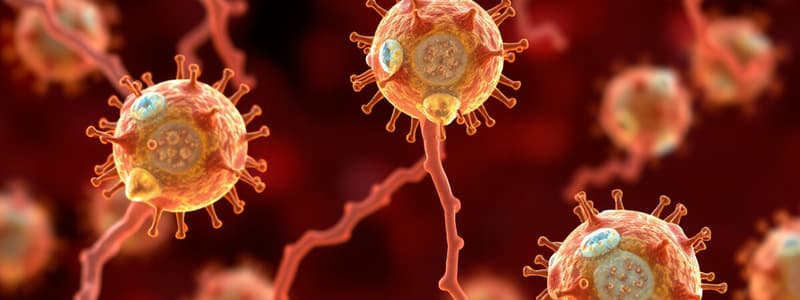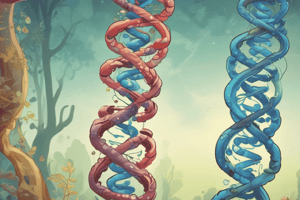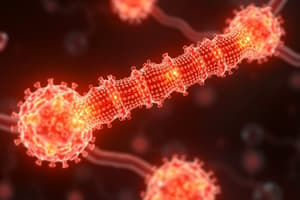Podcast
Questions and Answers
What happens to cells without telomerase once their telomeres reach critically short lengths?
What happens to cells without telomerase once their telomeres reach critically short lengths?
- They enter a state of senescence. (correct)
- They undergo apoptosis.
- They transform into cancer cells.
- They continue to proliferate indefinitely.
How is cellular senescence related to cancer?
How is cellular senescence related to cancer?
- It has no effect on cancer.
- It serves as a tumor-suppressing mechanism. (correct)
- It only affects immune cells and does not influence cancer.
- It promotes cancer development.
What is the 'Hayflick limit'?
What is the 'Hayflick limit'?
- The point at which cells become cancerous.
- The maximum number of times a cell can divide before senescence. (correct)
- The minimum telomere length required for division.
- The total lifespan of a cell after restoring telomerase activity.
What is the effect of restoring telomerase activity in senescent cells?
What is the effect of restoring telomerase activity in senescent cells?
Which statement regarding telomerase activity is true?
Which statement regarding telomerase activity is true?
What is the primary function of telomeres in relation to DNA replication?
What is the primary function of telomeres in relation to DNA replication?
Which of the following describes telomerase?
Which of the following describes telomerase?
What is the consequence of telomere attrition over time?
What is the consequence of telomere attrition over time?
Which type of stem cells are primarily used for clinical applications today?
Which type of stem cells are primarily used for clinical applications today?
What is the end-replication problem?
What is the end-replication problem?
Which of the following best describes the role of iPS cells?
Which of the following best describes the role of iPS cells?
What is a potential application of organoids derived from cultured stem cells?
What is a potential application of organoids derived from cultured stem cells?
Which of the following statements is true regarding stem cell therapies?
Which of the following statements is true regarding stem cell therapies?
What is the significance of telomeres in the context of aging?
What is the significance of telomeres in the context of aging?
What is the role of telomerase in cellular aging?
What is the role of telomerase in cellular aging?
What happens when telomeres become critically short?
What happens when telomeres become critically short?
Which of the following components directly contributes to telomere replication?
Which of the following components directly contributes to telomere replication?
Which factor is NOT related to the decline of telomere length?
Which factor is NOT related to the decline of telomere length?
What challenges are associated with the lagging strand during DNA replication?
What challenges are associated with the lagging strand during DNA replication?
What characteristic primarily defines telomeres?
What characteristic primarily defines telomeres?
Which statement about the Nobel Prize for Medicine in 2009 is accurate?
Which statement about the Nobel Prize for Medicine in 2009 is accurate?
What is one consequence of TERC knockout in late generations of mice?
What is one consequence of TERC knockout in late generations of mice?
What impact does over-expression of TERT protein have on mice?
What impact does over-expression of TERT protein have on mice?
Which of the following is NOT proposed as a factor contributing to organismal aging?
Which of the following is NOT proposed as a factor contributing to organismal aging?
What is the effect of 'heterochronic parabiosis' on aged mice?
What is the effect of 'heterochronic parabiosis' on aged mice?
What consequence does exposing young mice to an aged systemic environment have?
What consequence does exposing young mice to an aged systemic environment have?
Which phenotype is associated with defective neural stem cells (NSC) in TERC knockout mice?
Which phenotype is associated with defective neural stem cells (NSC) in TERC knockout mice?
Which statement best describes the relationship between telomere length and aging?
Which statement best describes the relationship between telomere length and aging?
What is a notable sign of infertility observed in late generations of TERC knockout mice?
What is a notable sign of infertility observed in late generations of TERC knockout mice?
What is a consequence of the leptin knockout experiment in mice?
What is a consequence of the leptin knockout experiment in mice?
Why are stem cells thought to be a possible origin for many cancers?
Why are stem cells thought to be a possible origin for many cancers?
What impact does the inactivation of quiescence signals have on stem cells in cancer?
What impact does the inactivation of quiescence signals have on stem cells in cancer?
What technique is exemplified by the introduction of specific gene modifications in embryos?
What technique is exemplified by the introduction of specific gene modifications in embryos?
What role do cancer stem cells play in tumor formation?
What role do cancer stem cells play in tumor formation?
What is a notable effect of gene knockout experiments, such as those involving leptin?
What is a notable effect of gene knockout experiments, such as those involving leptin?
How do regulatory signals differ in stem cells associated with cancer compared to normal stem cells?
How do regulatory signals differ in stem cells associated with cancer compared to normal stem cells?
How have embryonic stem cells been utilized in research related to certain genetic conditions?
How have embryonic stem cells been utilized in research related to certain genetic conditions?
Flashcards
Telomeres
Telomeres
The ends of linear chromosomes are protected by specialized DNA sequences called telomeres. These sequences are repetitive and non-coding, preventing the loss of genetic information during DNA replication.
End Replication Problem
End Replication Problem
The inability of DNA polymerase to fully replicate the ends of linear chromosomes due to the need for a primer.
Telomerase
Telomerase
A specialized enzyme that adds repetitive DNA sequences to the ends of chromosomes, preventing the loss of genetic material during replication.
Cell Senescence
Cell Senescence
Signup and view all the flashcards
Telomere Attrition
Telomere Attrition
Signup and view all the flashcards
Adult Stem Cells
Adult Stem Cells
Signup and view all the flashcards
Embryonic Stem Cells
Embryonic Stem Cells
Signup and view all the flashcards
Induced Pluripotent Stem Cells (iPS Cells)
Induced Pluripotent Stem Cells (iPS Cells)
Signup and view all the flashcards
Aging
Aging
Signup and view all the flashcards
Genetic Component of Aging
Genetic Component of Aging
Signup and view all the flashcards
Environmental Component of Aging
Environmental Component of Aging
Signup and view all the flashcards
Hayflick Limit
Hayflick Limit
Signup and view all the flashcards
Shutting Down Telomerase
Shutting Down Telomerase
Signup and view all the flashcards
What are stem cells?
What are stem cells?
Signup and view all the flashcards
What are hematopoietic stem cells?
What are hematopoietic stem cells?
Signup and view all the flashcards
What is gene targeting?
What is gene targeting?
Signup and view all the flashcards
What is a gene knockout experiment?
What is a gene knockout experiment?
Signup and view all the flashcards
What are cancer stem cells?
What are cancer stem cells?
Signup and view all the flashcards
How are stem cell regulatory signals linked to cancer?
How are stem cell regulatory signals linked to cancer?
Signup and view all the flashcards
What is the biology of aging?
What is the biology of aging?
Signup and view all the flashcards
What determines how long we live?
What determines how long we live?
Signup and view all the flashcards
Heterochronic Parabiosis
Heterochronic Parabiosis
Signup and view all the flashcards
Altered Cell-Cell Communication Signals
Altered Cell-Cell Communication Signals
Signup and view all the flashcards
Study Notes
Telomeres, Telomerase, and Aging
- Telomeres are heterochromatic DNA sequences that are repetitive
- Telomeres are located at the ends of chromosomes
- Telomeres are crucial for protecting chromosomes from degradation and fusion
- The end-replication problem is a key challenge in DNA replication
- Telomerase is a ribonucleoprotein that helps elongate chromosome ends
- Telomerase is essential for maintaining telomere length
- Telomere attrition leads to cell senescence, which is a type of cellular aging
- Cell senescence is a tumour-suppressing mechanism
- Telomere length varies among species, individuals, and cell types
- Telomere length shortens with age.
Stem Cells and Aging
- Adult stem cells, as well as embryonic stem cells, and induced pluripotent stem (iPS) cells play an important role in organismal aging.
- Stem cell renewal and pro-cancer pathways are interconnected
- Stem cells are likely the source of many cancers, due to their long lifespan and inherent pro-liferative nature.
- Many factors influence the regulation of stem cells, and disruption to these factors can result in diseases/cancers.
iPS Cells
- iPS cells can be produced from adult cells and can be utilized to study and treat genetic diseases
- iPS cells can act as a source for creating organoids
Organoids
- Organoids can be obtained from various tissue types, such as crypts or epithelial mini-guts
- Organoids are useful for experimental research, diagnostics, and regenerative medicine.
Adult Hematopoietic Stem Cells
- Adult hematopoietic stem cells are frequently utilized in clinical settings
- Treatments involve chemotherapy or radiation to kill cancer, which also damages hematopoietic cells
- Strong chemotherapy or radiation is used to kill cancerous cells, but also destroys healthy hematopoietic cells.
Basic Science Applications of ESCs
- Specific gene modifications are introduced to mice using embryonic stem (ES) cells, which allowed scientists to identify the precise function of certain genes and their role in cellular processes.
- This work opened the door for further understanding and eventually led to the 2007 Nobel Prize in Physiology or Medicine.
Gene Knockout Experiment (Leptin)
- A gene knockout experiment on leptin knockout mice demonstrated the role of leptin in regulating body fat and hunger; it also resulted in obesity and susceptibility to diabetes.
Nine Proposed Hallmarks of Organismal Aging
- Nine characteristics of aging are presented
- The hallmarks include genomic instability, telomere attrition, epigenetic alterations, proteostasis loss, nutrient sensing alterations, and more. . These characteristics influence each other, and their interplay is vital to our understanding of aging.
Interventions that Might Extend Human Healthspan
- Clearance of senescent cells, and stem-cell-based therapies, are important steps towards extending human lifespan.
- Multiple avenues of investigation exist to combat premature aging.
Telomere Replication
- Telomere replication plays a crucial role in maintaining chromosome integrity and stability.
Studying That Suits You
Use AI to generate personalized quizzes and flashcards to suit your learning preferences.




